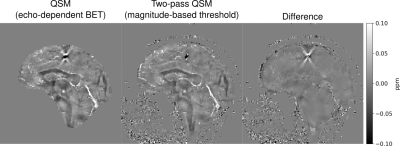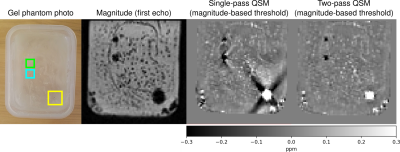Ashley Stewart1,2, Simon Daniel Robinson2,3, Kieran O'Brien1,2,4, Jin Jin1,2,4, Georg Widhalm5, Gilbert Hangel3,5, Angela Walls6, Jonathan Goodwin7,8, Korbinian Eckstein3, Markus Barth1,2,9, and Steffen Bollmann1,2,9
1Centre for Innovation in Biomedical Imaging Technology, University of Queensland, Brisbane, Australia, 2Centre for Advanced Imaging, University of Queensland, Brisbane, Australia, 3High Field MR Center, Department of Biomedical Imaging and Image-Guided Therapy, Medical University of Vienna, Vienna, Austria, 4Siemens Healthcare Pty Ltd, Brisbane, Australia, 5Department of Neurosurgery, Medical University of Vienna, Vienna, Austria, 6Clinical & Research Imaging Centre, South Australian Health and Medical Research Institute, Adelaide, Australia, 7Department of Radiation Oncology, Calvary Mater Hospital, Newcastle, Australia, 8School of Mathematical and Physical Science, University of Newcastle, Newcastle, Australia, 9School of Information Technology and Electrical Engineering, University of Queensland, Brisbane, Australia
1Centre for Innovation in Biomedical Imaging Technology, University of Queensland, Brisbane, Australia, 2Centre for Advanced Imaging, University of Queensland, Brisbane, Australia, 3High Field MR Center, Department of Biomedical Imaging and Image-Guided Therapy, Medical University of Vienna, Vienna, Austria, 4Siemens Healthcare Pty Ltd, Brisbane, Australia, 5Department of Neurosurgery, Medical University of Vienna, Vienna, Austria, 6Clinical & Research Imaging Centre, South Australian Health and Medical Research Institute, Adelaide, Australia, 7Department of Radiation Oncology, Calvary Mater Hospital, Newcastle, Australia, 8School of Mathematical and Physical Science, University of Newcastle, Newcastle, Australia, 9School of Information Technology and Electrical Engineering, University of Queensland, Brisbane, Australia
Our echo-dependent masking strategy reduces streaking artefacts in QSM near tissue boundaries. Our threshold-based and two-pass QSM strategy further reduces streaking near strong sources such as lesions and enables robust masking outside the brain.

QSM results using the QSM challenge dataset. Our two-pass QSM technique reduces streaking artefacts near the brain lesion and includes more brain detail.

QSM results using our gel phantom dataset. On the left is a photo of the gel phantom containing a gold fiducial marker with 1.5% iron content (yellow square), a pure gold fiducial marker (blue square), and a tooth piece (green square). The latter three images depict the same slice from the magnitude, single pass, and two-pass QSM. The two-pass QSM image has a clear reduction of streaking artefacts surrounding the strong sources.
